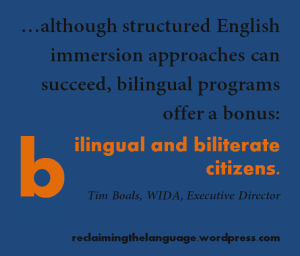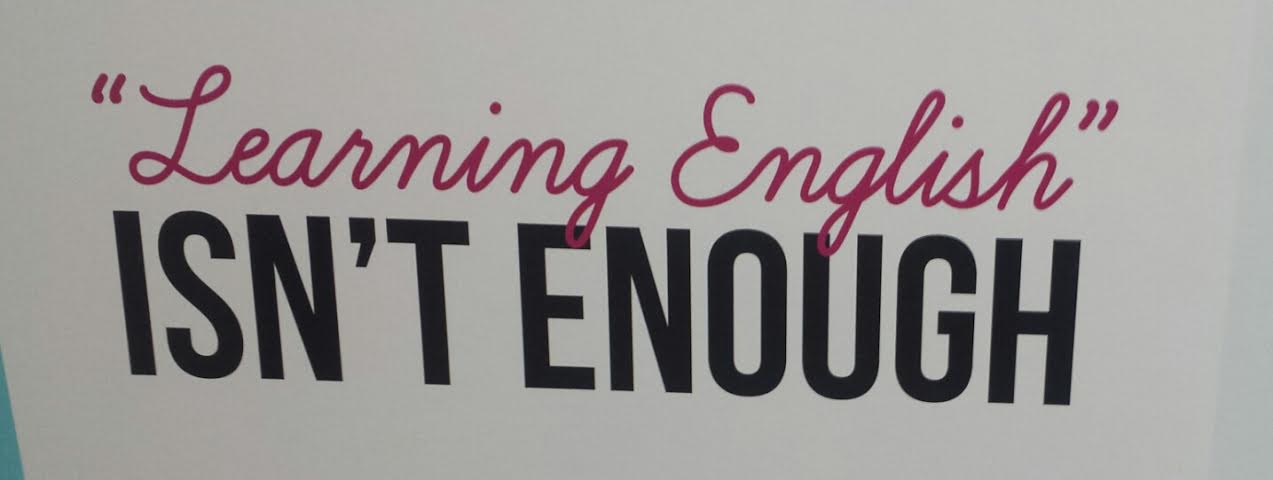By Dr. Timothy Boals , WIDA Executive Director, Wisconsin Center for Education Research (WCER), University of Wisconsin-Madison
Originally published for WCER on December 2, 2013. The original post is here.
For years we’ve heard the debate about whether teachers should use bilingual or English-only instruction when teaching English Language Learners (ELLs). This debate overlooks a more important issue: How can educators ensure ELLs’ overall academic success—not merely their acquisition of basic English?
The argument about educating ELLs is often more political than pedagogical. Framing the issue in terms of which approach is best for “learning English” has misled educators and the public. Learning English is simply not enough when the majority of students are also learning math, science, social studies, the regular English language arts curriculum, and many other subjects.
Policy makers and the public remain largely unconvinced of the role of the student’s native language and the need for long-term support. They see the purpose of bilingual or ESL programs solely in terms of compensatory English skills instruction, not as an issue of access and mastery of the whole academic curriculum.
The insistence on seeing English skills as a prerequisite for, rather than an outcome of, a meaningful school experience costs ELL students valuable time they need to close the academic learning gap.
The classical bilingual education debate has tended to revolve around two program models: transitional bilingual education and structured English immersion. Both typically last three years or fewer and are called “early exit” programs. Both have an English as a second language component where students learn to speak, read, and write English.
Both models are traditionally mostly remedial and are often taught through pull-out approaches, where the ELL student leaves the regular classroom and goes to a bilingual or ESL teacher for a number of hours per week “to learn English.” But these remedial programs become linguistic and cultural “ghettos” that isolate students from normal, content-rich classrooms. Neither model aligns itself with what regular classroom teachers teach. To meet the needs of ELLs, schools should shift away from such isolated programs toward integrated, inclusive programs throughout schools.
And three years is simply not enough time. Early exit programs drop support too soon, just at the point where ELL students are learning basic conversational skills. They still lack sufficient academic and literacy supports to ensure success as they move toward the more difficult content covered in succeeding grades.
For that reason education researchers favor what are called “late-exit” programs, which offer sustained support for academic progress. They usually last 4–6 years, or as long as it takes to be confident that students have the knowledge to thrive academically.
Instruction in the student’s native language is important. For children to understand and benefit from classroom work they must receive input that is comprehensible to them. Children who enter schools not speaking English find that most everything they hear is incomprehensible.
Beyond that, each academic subject presents its own unique discourse issues that involve distinct terms, concepts, and ways of relating to others. Each academic subject requires a certain degree of conceptual background knowledge, attained in either the student’s first or second language, to ultimately make the curriculum comprehensible. These skills, even with adequate support, take 5–7 years to fully develop for most ELL students.
Remedial programs are often highly teacher-directed. This orientation, as opposed to student-centered approaches, tends to be more tightly controlled by teachers and allows less time for students to engage in small group learning activities that have proven effective.
Late-exit programs, in contrast, emphasize cooperative learning, experiential discovery-based approaches, integrated language arts, and interdisciplinary thematic teaching. These methods emphasize acquiring language through the common core academic content and are designed to be highly interactive.
A number of recent studies have identified practices that appear to help ELL students master high-quality curricula in core academic subjects:
- long-term support is better than early exit,
- content-based support within language and literacy-rich environments is superior to traditional remedial or basic language teaching, and
- programs that also develop native language skills are significantly better than English-only approaches when and to the extent that schools can provide them.
If academic success in the mainstream classroom is the ultimate goal for ELL programs, programs with an initial advantage are those that begin teaching the common academic curriculum in the language students understand. Without native language support as one of the tools, schools often struggle to provide a quality curriculum to ELLs who are just  beginning to learn English. It is possible to reach these students but it’s not easy. For communities that contain a sizable population of language-minority students it makes sense to maintain and develop the language of the linguistic minority and to share it with the majority. That would seem to be bilingual education’s best hope for more widespread implementation, where feasible.
beginning to learn English. It is possible to reach these students but it’s not easy. For communities that contain a sizable population of language-minority students it makes sense to maintain and develop the language of the linguistic minority and to share it with the majority. That would seem to be bilingual education’s best hope for more widespread implementation, where feasible.
Although structured English immersion approaches can succeed, bilingual programs offer a bonus: bilingual and biliterate citizens.
The traditional insistence on framing the bilingual education debate simply around quick mastery of English versus maintenance of the native language has led most researchers and policy makers to repeatedly ask the wrong questions. The answers to those questions never seem to get any clearer. But if we begin by defining the purpose of schooling in terms of academic success, and if we see success for ELLs as an issue both of long-term support and access to mainstream curriculum, then we are offered the prospect of creating programs that truly work for these students.
 Tim Boals is the Executive Director of the WIDA Consortium. He holds a Ph.D. in curriculum from the University of Wisconsin-Madison with an emphasis in the education of English language learners (ELLs). His background includes language education, educational policy for ELLs, and Spanish language and literature.
Tim Boals is the Executive Director of the WIDA Consortium. He holds a Ph.D. in curriculum from the University of Wisconsin-Madison with an emphasis in the education of English language learners (ELLs). His background includes language education, educational policy for ELLs, and Spanish language and literature.
As the WIDA Executive Director, Tim oversees operations and long range planning, research, and consortium outreach efforts. His research interests involve the interplay between content and language learning for English language learners across the language acquisition continuum and the effects of standards on classroom practice for these learners. He is currently collaborating on a teacher handbook for formative language assessment, an edited volume on adolescent literacy development for ELLs, a chapter on how Latinos’ school success is influenced by cultural perceptions, and an article on how teachers can facilitate productive language interactions within small groups. Tim frequently presents at conferences in the U.S. and internationally on the challenges facing linguistically and culturally diverse learners and how schools and educators can better meet their needs.

Reblogged this on broadyesl.
LikeLike
Reblogged this on So, You Think You Can Teach ESL?.
LikeLike
i totally agree! i find this very interesting as i myself would love to improve not only my english grammar .
LikeLike